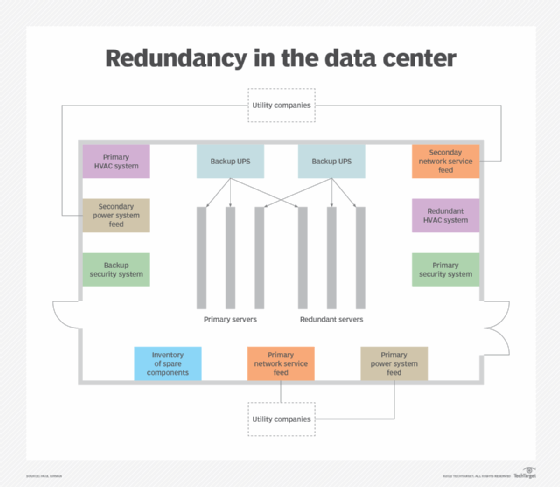What Happens to Redundancy If Company Goes Bust? An Overview to Your Rights
What Happens to Redundancy If Company Goes Bust? An Overview to Your Rights
Blog Article
Exploring the Operational Dynamics of Firm Redundancy and Its Long-Term Sustainability

Redundancy Techniques for Service Continuity
In order to make sure nonstop procedures, organizations have to execute reliable redundancy methods for company continuity. Redundancy in this context refers to the replication of essential parts or features within a system to reduce the influence of potential failures. By including redundancy approaches, companies can improve their durability versus disruptions triggered by numerous aspects such as natural calamities, devices failings, or cyber-attacks.
One usual redundancy technique is the implementation of back-up systems and information storage space options. This involves producing duplicates of important information and systems that can be triggered in situation of a primary system failure. Furthermore, organizations can establish repetitive interaction channels and power resources to maintain connection and operations during unexpected events.
Moreover, cross-training employees to execute several functions within the company can function as a beneficial redundancy technique. This makes certain that necessary jobs can still be accomplished also if crucial personnel are unavailable because of disease or other reasons. In general, effective redundancy approaches are crucial for organizations to maintain operational continuity and decrease the effect of possible disruptions.
Influence of Redundancy on Organizational Resilience
Given the important function redundancy strategies play in guaranteeing organization continuity, discovering the effect of redundancy on organizational strength becomes vital for comprehending the all natural operational characteristics of a company. Business strength refers to an entity's capacity to adapt to disruptions, recoup from troubles, and transform when necessary while keeping core functions. Redundancy, when purposefully executed, can considerably add to improving a company's durability despite unexpected challenges. By having backup systems, personnel, or processes in position, companies can much better stand up to shocks and proceed operations with very little interruption.
In addition, redundancy can cultivate innovation and creative thinking within a company as employees feel encouraged to take calculated threats, recognizing that there is a security net to support them in situation of failure. On the whole, the influence of redundancy on business resilience is extensive, shaping the long-lasting sustainability and success of a business.
Balancing Effectiveness and Adaptability in Redundancy
Accomplishing an unified stability between functional efficiency and adaptive adaptability is a critical difficulty in the critical implementation of redundancy within companies. Also much flexibility without a solid operational foundation can result in inefficiencies and disparity.
To stabilize efficiency and adaptability in redundancy planning, organizations need to thoroughly examine their functional needs, market characteristics, and calculated objectives. Executing lean techniques can boost efficiency by enhancing procedures and eliminating waste, while cultivating a culture of flexibility and continual enhancement can improve adaptability. In addition, investing in cross-training programs and robust interaction networks can help grow a versatile workforce efficient in taking care of diverse tasks during durations of change. Ultimately, more information finding the ideal balance between effectiveness and flexibility is essential for developing a sustainable and resilient organization in the face of uncertainty.
Long-Term Sustainability Through Redundancy Preparation
To guarantee long-lasting feasibility and security, organizations need to purposefully straighten their redundancy read the article planning with long-term sustainability goals, therefore balancing operational efficiency with adaptive adaptability. Long-term sustainability with redundancy planning entails greater than simply short-term cost-cutting procedures. It requires an extensive strategic technique that prepares for future difficulties and opportunities. Business must see redundancy not as a reactive service to instant troubles yet as a positive approach for lasting success. By integrating redundancy planning with sustainability goals, companies can create a durable framework that can stand up to different market fluctuations and internal changes.

Aggressive Measures for Sustainable Company Operations
Exactly how can firms proactively improve their operational sustainability for lasting success? Executing proactive procedures is important for business aiming to guarantee sustainable procedures. One vital approach is to purchase modern technology and innovation to simplify procedures, reduce waste, and stay affordable in the market. Embracing sustainable techniques such as decreasing power consumption, minimizing carbon impact, and maximizing resource application can not only profit the environment yet additionally cause cost financial savings over time.
In addition, promoting a society of constant renovation and discovering within the company can boost flexibility to changing market conditions and consumer needs. Encouraging worker participation in decision-making procedures and providing opportunities for professional growth can improve morale, performance, and overall efficiency. Establishing clear goals, checking essential performance signs, and routinely reviewing progress are crucial parts of positive sustainability monitoring.
Teaming up with suppliers, clients, and various other stakeholders to advertise lasting practices throughout the supply chain can develop a ripple impact of favorable effect - redundancy pay if company goes bust. link By taking aggressive actions in the direction of functional sustainability, business can construct strength, drive technology, and safeguard their long-term success in an ever-evolving business landscape
Verdict

In the realm of business monitoring, the critical deployment of firm redundancy stands as an essential yet elaborate technique that demands a delicate equilibrium between operational effectiveness and long-term practicality. By exploring the operational dynamics that underpin business redundancy and evaluating its more comprehensive ramifications for business strength and versatility, a nuanced understanding of exactly how redundancy approaches can shape the future trajectory of a business begins to unfold.Provided the essential role redundancy approaches play in guaranteeing service connection, exploring the influence of redundancy on organizational durability becomes necessary for recognizing the alternative functional dynamics of a company. Overall, the impact of redundancy on organizational resilience is profound, shaping the long-lasting sustainability and success of a firm.
In conclusion, recognizing the functional dynamics of firm redundancy is vital for ensuring long-term sustainability.
Report this page